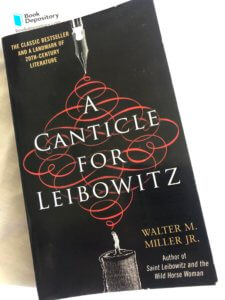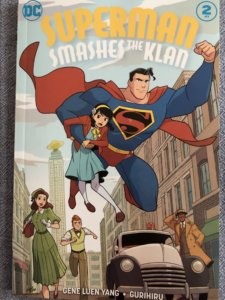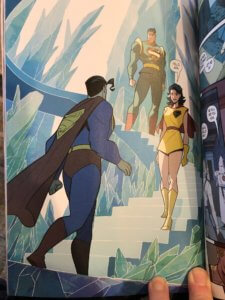Posts Tagged ‘books’
WIDOWLAND A No Spoiler Review of the Novel
Five Reasons I recommend WIDOWLAND, by C.J. Carey
- Excellent pacing and page-turning tension
- A young female hero who comes into her agency in a believable way
- Legit world-building of a bleak UK governed by Nazis
- The writing around the sexual relationships feels vital and true (more on this in the longer review)
- Given the consistent point of view and straightforward timeline, I’m guessing this would make a great audiobook
To purchase WIDOWLAND, click here
The Longer Review…
To control the past, they edited history. To control the future, they edited literature.
WIDOWLAND is an alternative history novel, set in London, 1953. This story would probably carry a PG-13 rating because of the sexual relationships although none of the sex scenes were explicit. For this reason, I wavered on the rating. Overall, the main sex scene was tastefully, even beautifully handled in terms of the emotional weight it carries within the story. Mature teens could handle this book. In fact, it might appeal to many female YA readers because the protagonist is a woman in her twenties.
For educators, WIDOWLAND provides a unique picture of what a society imagined by the Nazis might look like and feel like. Great fodder for discussion. Moveover, it portrays (accurately so) literature as a disrupter of those who broker power.
In this alternative history, Germany has invaded the UK and Hitler rules over it as a protectorate. The coronation of Edward the VIII (Queen Elizabeth’s uncle) and the American divorcee, Queen Wallis, is taking place soon. Significant because The Leader, Hitler himself will descend on London for the celebration. The soon-to-be King and Queen of England are collaborators with the Nazis, based on an actual historical and private meeting that took place between the Edward and Hitler at the Berghof in 1937. (No record of the meeting has survived).
The story, told in close third person by the main character, Rose Ransom, opens with a description of London preparing for the coronation. Through Rose’s eyes, the world unfolds. The reader quickly understands, that although Rose holds little power in the system, she sits at the top of the subjugated population as a Geli. She is young and her view of reality is sometimes naive and not always reliable, but the discoveries she makes along the way are a part of how Carey maintains tension in the story. The reader senses the danger she does not.
This is a story about a woman and about women living under Nazi occupation. Carey could have gone overboard painting the world, but deftly focuses the reader’s attention on the kind of oppression that exists in England for the vulnerable. The elderly, women and widows in particular, suffer under the yoke of the Nazis. She highlights the caste system which categorizes the “utility” of women. In this early excerpt, the reader begins to understand Carey’s 1953 London.
Members of the first and elite caste were popularly called Gelis after the woman most loved by the Leader, his niece Geli. Klaras–after the Leader’s mother–were fertile women who had produced, ideally, four or more children. Lenis were professional women, such as office workers and actresses, after Leni Riefenstahl, the regime’s chief film director. Paulas, names after the Leader’s sister, were in the caring professions, teachers and nurses, whereas Magdas were lowly shop and factory employees and Gretls did the grunt work as kitchen and domestic staff. There was a range of other designations–for nuns, disabled mothers and midwives–but right at the bottom of the hierarchy came the category called Friedas. It was a diminutive of the nickname Friedhöfefrauen–cemetary women. These were the widows and spinsters of over fifty who had no children, no reproductive purpose, and who did not serve a man.
There was nothing lower than that.
Rose first runs into trouble when the Cultural Commissioner of the UK Protectorate asks that she help him solve a mystery. She is to venture into Widowland and spy on a group of Friedas. An uprising is bubbling to the surface in London right as Hitler is set to arrive. These disempowered women are the suspected Nazi resisters. The clock is ticking and Rose’s big boss makes known to her that more than just her job is on the line if she fails.
What unfolds is a story of discovery for Rose and choices that will impact many.
One comment about the sexual relationships in this novel. The sex is not explicit. There is an implied disorder to the relationship between Rose and her lover, who is twenty-five years her senior. The power dynamics and how German men use power to procure beautiful young women is a part of the world these characters inhabit and is taken for granted in the novel world. However, the author adds a scene that is emblematic of sex within a loving relationship. The revelation that comes to Rose and the writing around this encounter are so poignant and beautiful, I will remember this passage of writing for a long time.
DUNE, Chapter 1. A Study on Craft
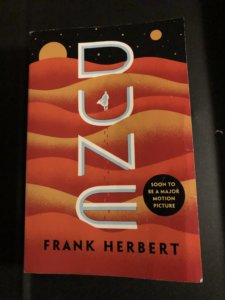
For educators: This post is appropriate for teens who have read Dune and might want to to improve their storytelling/writing skills.
I happen to be in a writing critique group that started up this past week. A couple of the folks in this group are writing novels and sent in first chapters for a swipe at getting feedback. So, I read a few first chapters yesterday and in the course of my reading, I began to wonder…Do these seem like first chapters to me? How do I feel as a reader as I am taking in the narrative for the first time? Do I begin to have a strong sense about the story, the characters and about the writing style? Absolutely. I did and do have feelings and ideas. Some of those made me want to keep reading. Others did not.
That led me to the question: How does a novelist write a brilliant chapter one that makes you want to keep reading?
I wonder about my own first chapter, the beginning of my novel that is undergoing an extensive edit. What is it accomplishing and what is it not accomplishing? Have I done the necessary work to hook my reader, keep them interested and engaged, settle them into the world I am creating?
All writers of any genre ponder this question when they sit down before the blank page because the possibilities are endless, as endless as stories themselves. However, I do think there are ways to understand first chapters, to critique and edit them for the purpose of making them better.
Therefore, I begin a series of posts devoted to the question of beginnings. My focus will be on science fiction and fantasy novels and the hope is not to be prescriptive. Telling the writer what to do or not do detracts from originality and art. However, paying attention to how great authors craft a narrative is worthwhile. We learn from the greats. Study enough greats and we begin to see common threads.
So, my goal in this series of posts is to plunder first chapters and see what I can glean about my own writing and will record my findings for the sake of other writers.
 A Look at DUNE, Chapter 1
A Look at DUNE, Chapter 1
Frank Herbert is a great writer and though the novel DUNE isn’t perfect, it’s very close to perfect. How does that first chapter set us up for a marvelous journey?
I see it accomplishing four things.
Chapter 1…
-Gives us a sense of the setting in which the story will take place
-Introduces the primary characters, even putting the main character through a first test
-Hints at the coming conflict
-Tantalizes the reader with compelling mysteries that make you want to keep reading
Chapter 1 of DUNE give us a sense of the setting.
Here is the first sentence of the novel.
In the week before the departure to Arrakis, when all the final scurrying about had reached a nearly unbearable frenzy, an old crone came to visit the mother of the boy, Paul.
Most of us have experienced moving houses, cities, states. We know what it feels like to change locations. In this first sentence of DUNE, the reader is alerted immediately to the fact that a change in location is taking place for this particular family, for this particular person, Paul. Moving is disruption. Paul’s family is about to be disrupted. He will soon be leaving Caladan for a planet called Arrakis, sometimes called Dune.
Soon after, in the early paragraphs, Herbert repeats this series of words three times as paragraphs. They jump out on the page like a refrain. They are written in italics, which in Herbert’s style, represents thought. Paul, the main character continues to mull over this reality.
Arrakis—Dune—Desert Planet
So, not only will Paul be leaving his current location, but the new location is harsh. There is a sense of foreboding about this desert planet. Paul will move from Caladan, a land where water is plentiful to Arrakis, where water is scarce. Caladan is known, comfortable, secure, a virtual paradise. Arrakis is mysterious, uncomfortable in so many ways, in part because of its climate. Climate will be a large issue in the rest of the novel. Herbert wants the reader to begin thinking about ecology and its importance to a planet and a people.
Here is the second sentence of DUNE.
It was a warm night at Castle Caladan, and the ancient pile of stone that had served the Atreides family as home for twenty-six generations bore that cooled-sweat feeling it acquired before a change in the weather.
When Paul’s family leaves Caladan, they are not only leaving their current comfortable home/castle, but they are leaving their home of twenty-six generations. This move is an epic move. The reader is left asking…why? Why leave this lovely planet and this home of so many years? We get a few clues as to why this move it taking place. Power and political maneuvering are introduced, a profound subject of the story.
Thufir Hawat, his father’s Master of Assassins, had explained it: their mortal enemies, the Harkonnens, had been on Arrakis eighty years, holding the planet in quasi-fief under a CHOAM Company contract to mine the geriatric spice, mélange. Now the Harkonnens were leaving to be replaced by the House of Atreides in fief-complete—an apparent victory for the Duke Leto. Yet, Hawat had said, their appearance contained the deadliest peril, for the Duke Leto was popular among the Great Houses of the Landsraad.
Arrakis is the place where the empire derives its most important resource: Melange, or spice, as it is sometimes called. Melange is the secret to space travel in this particular universe.
We can already see now how the chess pieces are stacking up, a sense of the conflict.
This brings us to the second accomplishment of Herbert’s chapter one, the introduction of most of the main characters.
Paul is mentioned in the first sentence. So is his mother. Paul’s mother and Paul are on the stage for the very final scene of the novel as well. In fact, his mother gives voice to the final paragraph/speech.
Not only that, but the crone mentioned in that first sentence, the one who will test Paul later in the chapter, will also be on that stage at the finale. This is great writing.
Add to the list the Bene Gesserit, the Fremen, House Harkonnen…all are mentioned, Thufir Hawat, (who will be present in the final scene) and Dr. Yueh, important as the one who betrays House Atreides…all are introduced in chapter 1.
Note this paragraph early in the chapter.
Paul awoke to feel himself in the warmth of his bed—thinking…thinking. This world of Castle Caladan, without play or companions his own age, perhaps did not deserve sadness in farewell. Dr. Yueh, his teacher, had hinted that the faufreluches class system was not rigidly guarded on Arrakis. The planet sheltered people who lived at the desert edge without caid or bashar to command them: will-o’-the-sand people called Fremen, marked down on no census of the Imperial Regate.
The Fremen will become important to the story, of primary importance, but the reader is simply introduced here. There is mystery surrounding these people. I am curious. I want to learn more and Herbert will plunge me into Fremen culture before too long.
It’s interesting to note who is left out of chapter 1.

Chapter 1 hints also at future conflict.
As Paul is undergoing the test, the gom jabbar, here is what the Reverend Mother, the crone says to him.
The old woman said: “You’ve heard of animals chewing off a leg to escape a trap? There’s an animal kind of trick. A human would remain in the trap, endure the pain, feigning death that he might kill the trapper and remove a threat to his kind.”
As I was re-reading the chapter last night, this nugget stopped me in my tracks. I had not realized, not seen how this Reverend mother quote foretells the remainder of the story.
Paul does feign death on Arrakis, so that he might kill the trapper and remove the threat to his family. That is, in essence, a summary of the novel. These two sentences are so brilliantly placed, subtle in all the best ways. We don’t understand consciously upon first reading, but Herbert has just told us what we can expect.
Lastly, chapter 1 teases the reader with mysteries.
This is an odd world, a mysterious one in which a mother of an only son, will give him up to a religious figure, knowing he might die.
Jessica stepped into the room, closed the door and stood with her back to it. My son lives, she thought. My son lives and is…human. I knew he was…but…he lives. Now, I can go on living.
This we absorb and I, at least, want to read to find out more about this bizarre world where such a thing would happen. In order to know more, I must keep reading.
Then, there is the planet Arrakis and the Fremen. In chapter one, we learn very little about them, but we wonder about them as Paul does. The planet is a desert and the Fremen seem to live off the grid. They are wild and uncounted by the empire. Who are they? We are meant to wonder, and to find out, I have to keep reading.
And lastly, in Chapter 1, Herbert introduces the reader to the idea of the Kwisatz Haderach, a messianic figure. Is Paul the Messiah? The reader suspects he is, though Paul himself struggles with this identity throughout the novel, mysterious even to him. We will have to keep reading if we want to figure out the true identity of the Kwisatz Haderach.
So…all of this in Chapter 1. I am wowed and I am hooked. I am also set up well in the world to take in more of the details as they unfold. Moreover, I have enough sense of the main characters to be able to navigate this complex world where many more characters will soon be introduced. It makes me wonder how many times Herbert went back to edit and perfect his beginning…because I don’t think he could have written a better version than the one we read today.
DUNE, A Review of the Novel

DUNE, the novel holds up well to post-modern scrutiny and the writing is mostly perfect.
This is a PG-13 story, for sexual and violent themes, although those scenes are not explicit in this novel.
The Short Review
5 Reasons the Science Fiction Fan Needs to Read this Book Now
- DUNE, the film will be released in 2021…at least the first film of two will be released…unless pandemic interferes. In this case as in most, I recommend reading before viewing
- Compelling villain and compelling hero, with complex motives for each
- Dynamic characters around the main character, including a number of strong females
- Among the best world-building you will find in science fiction
- Without simplifying the complexity of good versus evil, this story gives the reader a vision of truth, goodness and honor
The Longer Review (mini spoilers below):
When George Herbert created the character Paul Atriedes, he stumbled upon a savior-type, a hero, a character who could embody a kind of leadership that most of humanity longs for. Hero stories are nothing new, certainly not new to the science fiction audience, but great ones are to be treasured.
In the case of DUNE, Paul is not the only treasure. The people of the planet Arrakis, the Fremen, also embody an ideal. They are oppressed, but intelligent, pushed to the margins of society, but resourceful and willing to sacrifice for the cause. Their discipline is akin to the greatest armies of literature and history. They are as creative as tenacious as a Roman legion, as fierce as Khan’s Mongols and as disciplined as the Spartans.
(Spoiler here) So what is supposed to get under our skin about DUNE? How can one argue with a story where the overly confident and utterly powerful Emperor is outsmarted, out-gunned and defeated by an honorable and humble tribal people? That feels so right and good.
But there are complexities that go along with this storyline. Paul is not as pure a hero as he might seem. His role as Messiah is an idea that plagues him throughout the novel because he knows he is not simply fighting for the Fremen. He is also motivated by vengeance and honor. He uses the Fremen to avenge his father, so his victory is an uneasy one. Even as he negotiates a marriage to the Emperor’s daughter for status and honor, but keeps his Fremen lover as concubine, the audience sees the inherent politics that will inhabit Paul’s governing. How Paul will rule the Empire is a story for later books, but the seeds of the struggle are sown well and deep in the original novel. So, even as the audience breathes relief at the victory over injustice, there is more to ponder.
To purchase the novel, click DUNE
There is also an amazing graphic novel version which is being released book by book. Dune is made up of three sections, called books. The first installment in graphic novel form is available here. To purchase, click DUNE, Graphic Novel The second installment will be released in the Spring of 2022. No date yet on the third and final.
Lastly, the 2021 theatrical trailer is out and worth a view, perhaps best seen after reading the novel…but then, maybe not.
Click here to see DUNE, film trailer
THE ANDROMEDA STRAIN, A No Spoiler Review
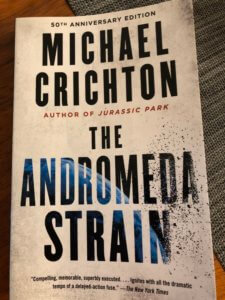
However, Crichton soon after became a best-selling author and gave up the idea of practicing medicine.
I read this novel because of a recommendation by a friend during Covid19…
Do I recommend this novel? No, I don’t and here are 5 reasons why:
- The novel puts forward an interesting premise, but not fully baked (I am pretty sure this novel would never get published today)
- Bland main characters. It’s hard to keep them straight, they all seem like the same guy (except they attended different Ivy League schools and have slightly different occupations)
- So-so tension, but nothing like one of his better books, Jurassic Park, for example
- Characters are all white dudes in lab coats and even the non lab-coat characters are all white dudes. *note…when THE ANDROMEDA STRAIN was turned into a film in 1971, the screenwriter changed one of the dudes to a female…even in the 70s the character line-up was thought to be way too monochromatic.
- Too much data and exposition and not enough heart. I felt nothing for all the people (except for the infant…who seems to be completely neglected)
Longer Review…
So…this novel became a best-seller and gave rise to a film that bears the same title. Both were hits/made a lot of money. In fact, this book catapulted Crichton’s career. I can only surmise that there was a great hunger for techno-thrillers at the time and that Crichton scratched an itch that had be itching for a long time.
The funny thing is, immediately following this read, I’m consuming Philip K. Dick’s, DO ANDROIDS DREAM OF ELECTRIC SHEEP and I am so wowed by the writing and how different it is from Crichton’s. Dick knew how to flesh out a character. Crichton did not, at least he didn’t yet. He got much better at it in subsequent novels, many of which I have enjoyed.
So, let me just nit-pick a little…
If I was ever to teach a writing class on the development of a writer…I might choose Crichton and force my class to read this book and then give them the pleasure of Jurassic Park as examples of how one gets better at the craft. THE ANDROMEDA STRAIN almost feels like a “freshman novel”, that novel written by an aspiring author who has one great idea, but can’t quite figure out how to tell the story.
In that class, I would also ask the students to read DO ANDROIDS DREAM OF ELECTRIC SHEEP, by Philip K. Dick, written in the same era.
There is a reason that BLADE RUNNER, a brilliant film and subsequent franchise, emerged out of Dick’s novel, published in 1968, one year before THE ANDROMEDA STRAIN.
The character of Rick Deckard is brilliantly written, fleshed out. The reader feels his pain, his angst, his story as he/she reads. Not only that, the secondary characters are complex, mysterious and full of emotion even when Dick writes about androids. His androids seem more human than Crichton’s actual human characters.
I do believe that Crichton saw his errors and improved immensely, but it will be a mystery to me for a long time that this book, THE ANDROMEDA STRAIN, was published and was sold and was read by so many, including me!
If for some reason you want to buy this book, click here.
To watch the film via Amazon Prime, click here.
A CANTICLE FOR LEIBOWITZ, by Walter M. Miller Jr., A No Spoiler Review
This morning, I finished reading the classic science fiction novel, A CANTICLE FOR LEIBOWITZ. I rate this novel PG for violence.
First, the short review…
To purchase the novel, click A CANTICLE FOR LEIBOWITZ.
5 Reasons I Recommend A CANTICLE FOR LEIBOWITZ
- If you are a science fiction fan and want to be fluent in the genre’s history, Leibowitz is on many lists of must read sci-fi.
- The novel’s world is depicted plainly and purposefully, capturing the tragedy of a post nuclear holocaust world without sentimentality. The prose is often lovely and the story becomes more and more gripping as it unfolds.
- Especially for the philosopher and the theologian, A CANTICLE FOR LEIBOWITZ puts forward some of the most profound ideas around human evil and our propensity for self-destruction.
- Even if you’re not a philosopher, the characters and ideas come together in a way that does not allow the reader to ignore our society’s seeming dance toward self-destruction.
- In a similar vein as On The Beach, by Nevil Shute, A CANTICLE FOR LEIBOWITZ is a story that has the capacity to change our minds about nuclear arms and warfare.
Longer Review
A CANTICLE FOR LEIBOWITZ was originally published in three parts.
Fiat Homo…Let there be man
Fiat Lux…Let there be light
Fiat Voluntas Tua…Let thy will be done
The first two section titles refer to the Biblical account of creation, when God spoke the earth and humankind into being. The third section’s title refers to the Christian New Testament. Not that the idea lacks foundation in the Hebrew Bible, but the phrase itself is taken from The Lord’s Prayer and Jesus’ prayer in Gethsemane before his death. “And he went forward a little, and fell on his face, and prayed, saying, My Father, if it be possible, let this cup pass away from me: nevertheless, not as I will, but as thou wilt.”
A fair amount of Latin is spoken in this novel and I did not understand all of it, but most phrases are translated within the story or the context makes the meaning clear. All of the main characters and narrators are associated with a religious order, the monks of The Leibowitzian Order, that was established following what the novel calls The Flame Deluge.
The monks, much like Irish monks during the Dark Ages, copy, preserve and make available ancient knowledge to those who will have it. For the most part, the barbarians who dwell around the monastic fortress, whose setting is the old American West, hate this knowledge and see it as the reason destruction came to the planet.
An excerpt from the novel:
“After the bombs and the Fallout came the plagues and the madness. Then, in the bloodletting known as the Age of Simplification, the people – those few who remained – rose up against their teachers, their scientists and their rulers, those they held responsible for turning the world into a barren desert…”
A CANTICLE FOR LEIBOWITZ, published in 1959, channels the zeitgeist of an era when people were genuinely terrified of and preparing for nuclear war. For many readers, especially, younger readers, that period of history can feel like a long time ago in a galaxy far far away…but given Covid19, the economic shock that has hit the globe through the shutdown as well as the rise of a belligerent Communist China and a perpetually divided United States, war and/or chaotic one-upsmanship between two superpowers seems less far distant than it has since 1989, when the Soviet Empire collapsed. If World War III were to happen today, what would be the fallout?
Many of the questions posed by Miller in A CANTICLE FOR LEIBOWITZ are relevant today. There is wisdom and a degree of sobriety that can be gained by our society paying closer attention to stories like this one.
THE CALCULATING STARS, A No Spoiler Review of the Novel:
THE CALCULATING STARS, by Mary Robinette Kowal
A Short Review
I highly recommend reading or listening to this novel. Below are 4 reasons why I loved it…
- Lots of dynamic female characters, told in first person by a female pilot/mathematician
- Well-written prose, making it easy to read and enjoy
- The characters are well drawn and realistic, despite the fact that they’re intellectual superstars
- It portrays a healthy marital relationship (for once!). Sometimes, you just want the husband to not be a jerk, and in this novel, that is absolutely the case. *Elma and her husband also enjoy a dynamic sex life, which is why I give the book a PG-13 rating. Nothing terribly graphic, but there are a few heated encounters between husband and wife.
THE CALCULATING STARS is a part of the Lady Astronaut Series, by Kowal, which includes a short story, The Lady Astronaut of Mars and another novel, The Fated Sky.
These stories emerge in an alternative history of Earth, focusing on the US Space program after a meteor plunges into the ocean off the coast of Maryland. The disaster strikes on March 3, 1952 and kills nearly all of the inhabitants of the Eastern Seaboard, including DC and most US government officials.
Kowal quickly frames the narrative from here. A meteorite of this magnitude will change the climate of the Earth forever. It is a matter of time (5-10 years) before the Earth becomes uninhabitable. Nations must work together to relocate to another planet and on this front, women have to be trained alongside men, don’t they? That is the question around which the book pivots. This is the 1950s and not only does racism rear its head in the space program, so does sexism.
The main character, Elma York narrates the story in first person, and I liked her as narrator. She is ambitious and brilliant, but flawed enough to give the story tension.
Elma is not only a renowned mathematician, she is also an experienced pilot, having flown for the WASPs in WWII. Her husband becomes the lead engineer of the new space program. Elma is recruited as one of the computers, seemingly an acceptable “role” for women in the new space venture (think Hidden Figures), but her real hope is to convince the NACA bosses that women are just as able to fly into space as men.
THE CALCULATING STARS won the 2019 Nebula for Best Novel, the 2019 Locus Award for Best Scifi Novel, the 2019 Hugo for Best Novel and the 2019 Sidewise Award for Alternate History.
Click here to purchase THE CALCULATING STARS
When Science Fiction Brings History Alive
I love science fiction, dreaming about the future, imagining what our life in outer space might look like someday, but my passion for the genre has as much to do with the past as it does with the future. Science fiction shows us the future but also has the ability to teach us about our past and often does so without the baggage of politics and biases. The stories below are launch pads. Their portrayals of history through story are not by any means comprehensive, but rather snapshots into the lives of people encountering challenges that may be imagined by the author, but mirror history.
Here are a handful of scifi stories that bring the reader face to face with the past:
- Superman Smashes the Klan
- The Man in the High Castle
- Colony
- An Excess Male
- Kindred
History Lesson #1. SUPERMAN SMASHES THE KLAN. Launch a discussion about the Ku Klux Klan (it’s inception and impact on US race relations).
In this three-issue Superman Comic, Gene Luen Yang gives historic tidbits at the end of each issue. You can read my review of the series here.
In issue 1,Yang highlights the 13th amendment to the constitution (abolition of slavery) and the 1882 Chinese Exclusion Act
Following issue 2, Yang discusses the Jewish immigrants who created Superman.
Following issue 3, Yang discusses the challenges of his own parents, both of whom were immigrants from Taiwan
History Lesson #2. Watch or read, THE MAN IN THE HIGH CASTLE (book by Philip K. Dick. The Amazon Prime TV series was produced by Dick’s daughter, Isa Dick Hackett). Discuss and learn about World War II.
This series is a great way to understand the Axis powers and that tentative alliance that almost took over the globe. You’ll find yourself or your student understanding the world that was inhabited by those who lived under occupation during that war. The French, The Koreans, and many others were forced to survive under Nazi or Japanese rule. Some made compromises, others rebelled. Can you imagine who you would have become to survive an occupation? That question is a great way for students to enter into and understand history.
History Lesson #3. Watch COLONY on Netflix to begin to grapple with the reality of living under occupation.
In the case of COLONY, the true enemy is an alien race that has invaded Earth, but some of the darkest villains are the human beings who have allied themselves with this conquering force.
Living under occupation, whether under the Greeks, Romans, The Islamic Caliphate, the Brits, the USSR, it requires turncoats, or those who will help to subdue the masses for the sake of the little bits of power and privilege that are doled out by the occupying power. The tv series COLONY does an amazing job of capturing this reality. A longer review can be found here.
History Lesson #4. Read AN EXCESS MALE, by Maggie Shen Chen, to begin to understand 20th century Chinese history.
Although this book imagines a future China, this story highlights what is perhaps the most disastrous public policy mandate of all time, THE ONE CHILD POLICY. For my review of this novel, click here. To read my guide for educators, click here.
History Lesson #5. KINDRED, by Octavia Butler. Read this book (fictional) and one of the other historic slave narratives like, MY LIFE AS A SLAVE, by Frederick Douglass. Discuss the ways slavery dehumanizes all those who participate in its reality.
KINDRED, by the late and great Octavia Butler, gives the reader a taste of the slave-inhabited South of yore. The brutality is evident and palpable. Lessons are brought so close…it’s hard to read this book, yet it is valuable for those trying to understand slavery in 18th and 19th century US. Here is my longer review of Kindred
SUPERMAN SMASHES THE KLAN ISSUE 3, A Review Without Spoilers
Read All Three Issues of SUPERMAN SMASHES THE KLAN You Won’t Be Sorry
 Short Review: Here’s why you need to read all three…
Short Review: Here’s why you need to read all three…
- Comic book action and a great story
- Relatable kid characters who make poor or good choices and learn from them
- Even Superman grows and changes
- History lesson combined with Gene Luen Yang memoir tidbits in the final pages of each issue are perfect for spurring deeper conversations about racism in the US
- I can’t get enough of Gurihiru’s lovely art
Longer Review:
It’s a sad season for many of us on planet Earth who are living under the threat of COVID19 spread. Schools have been shuttered, so many activities cancelled and parents are left trying to figure out how to keep their kids off screens and at least somewhat engaged in their education. Great books, ones your kids will be motivated to read without any of your coaxing, are the home-school parent’s best friend.
On my website, you can use the menu bar for educators to see what science fiction books might appeal to your student. It’s not an exhaustive list, but there are more than a few gems you’ll want to check out. When I review a book, I give the story a movie type rating…G, PG, PG-13, etc.
If you want to read a review of issue 1 of this series, click SUPERMAN SMASHES THE KLAN, A No Spoiler Review
If you want to read a review of issue 2, click here
In the case of issue 3, I have no reservations in recommending this book to all kids and adults, though you might give it a PG rating for the serious topic it tackles, racism and violence.
The story (as portrayed in all three issues) is accessible to a child. He/she might need to be old enough to engage in a basic conversation about race, justice and belonging, but my experience in having two kids who attended public schools in California, they were ripe for the beginning of that conversation by kindergarten. I would recommend you don’t shield your young ones from starting this conversation early.
In this third issue of SUPERMAN SMASHES THE KLAN, the story climaxes with a confrontation between Superman and the Klan of the Fiery Cross. Superman has befriended the Lees, an Asian American family that has moved out of Chinatown and into the suburbs. They are the focus of the Klan’s animosity and Superman is defending them against the Klan’s violence. Author, Gene Luen Yang does not pull punches. There is a real portrayal of race hatred in this comic series, but that is what makes this story all the more powerful…it delivers truth.
Roberta, the young sister in the Lee family plays a crucial role in helping Superman beat back injustice. She will appeal to both girls and boys with her quirks (in the opening sequence of the first issue, she gets car sick and has to throw up while her family is driving out of Chinatown) and her bravery (she confronts evil and injustice head on, even though she can’t always defend herself). In this issue, Lois Lane takes Roberta under her wing and encourages her to research a mystery for the Daily Planet as a cub reporter. Roberta is a wonderful hero.
Given the talented writer that he is, Yang draws out a number of characters on both sides of the conflict who have depth. The bad guys are more than just foils. Likewise, the good guys are not always perfect. Even Superman is grappling with flashbacks around his own childhood, trying to make sense of his alien nature. It’s one of a number of great storylines that will please the Superman fanatic and add much to the themes that emerge in SUPERMAN SMASHES THE KLAN.
A bonus delight in all the issues are the final pages where Gene Luen Yang puts forward a bit more history of his own immigrant story and that of the Klan…In a vulnerable and testimonial way, he reflects on both the challenges and the beauty of our mixed cultural nation.
SUPERMAN SMASHES THE KLAN is a story in three issues. One issue every other month released since October. This is something comic book readers understand. You buy one issue, read about your favorite hero and wait in anticipation for the next issue to come out. Comic book adventures are serial-styled stories. Each comic book usually contains one story arc and always ends with a cliffhanger. That is one reason why readers buy the next issue. There is delight in this way of consuming a story, but it requires more patience than most of us are used to.
In case that style does not appeal to you or your child, buy all three. All three SUPERMAN SMASHES THE KLAN issues contained in one book, a story that will grab your child and keep him or her reading. The three will be released together on May 12. To preorder the story in one paperback instead of 3 separate issues, click here.
My advice in case you plan to discuss race with your child, make sure you read the story too. The education that will come out of the reading will benefit parent and child.
To buy SUPERMAN SMASHES THE KLAN, ISSUE 3, click here.
To buy the previous issues, click
SUPERMAN SMASHES THE KLAN, Part 2
SUPERMAN SMASHES THE KLAN Part 2 hit comic book stores in December. It’s over a month old and I have been delinquent in reviewing it, until today. This story is appropriate for just about all readers. Rated PG.
For a review of Part 1, see this no spoiler review
Warning: This review will have spoilers if you have not read the first installment.
Inspired by the 1940s radio series Clan of the Fiery Cross, Gene Yang picks up the cliff-hanger from part 1. In part 1, Tommy Lee, a Chinese-American boy has been abducted by a white supremacist group, Klan of the Fiery Kross.
The aim of the Klan is to tar and feather Tommy, therefore teaching his parents a lesson. They resent the Lees moving out of Chinatown and into their white neighborhood. The Lee family has made this move because Dr. Lee, Tommy’s father, has been offered a job in a nearby lab.
All the storylines ratchet up a notch in Part 2.
Worth noting:
- Superman backstory: Superman continues to have flashbacks of his parents, aliens who look very different than humans. He is grappling with his own “alien” identity. His journey parallels the journey of the immigrants and their children in the story
- A little bit of romance: Yes, it’s a bit comedic and fun to see the budding affection between Superman and Lois and a little flare between Jimmy and Roberta, the main character in the story, the Lee’s spunky daughter.
- A community undergoing change: Yang captures an aspect of American life that rings true…especially, second generation immigrants moving out of the inner cities, out of enclaves and integrating into white America, changes that have historically led to tension. As in Part 1, Yang treats the “bad guys” fairly, always grappling with their feelings and their perspective. Not excusing their views or actions, but giving all his characters humanity.
- Another history lesson/bio on race relations in the US: At the end of the comic, a memoir section called Superman and Me describes Gene Yang’s childhood relationship with Superman and other comic heroes. Underneath Yang’s love affair with comics is the power of story and how they provided a sense of identity and empowerment for the author. In case you’re enamored by the history lesson, consider Yang’s early graphic novel masterpiece, American Born Chinese Definitely worth owning and passing around to friends, especially young teens.
Overall, this is a great middle to the story. I look forward to reading the finale, Part 3 when it is released on February 19, 2020.
A note on the art: The art in the series, created by Gurihiru, is colorful, capturing a blend of retro and anime. It seems apropos that this Japanese female duo would create the artwork for a comic grappling with some of the first Asian-American characters portrayed in a sympathetic way in the American Comics Universe.
To buy Part 1, click here
To buy Part 2, click here
Best Science Fiction and Fantasy of 2019. Worthy of a Post. Worthy of Purchase.

Writes editor John Joseph Adams…”The BEST AMERICAN SERIES is the premier annual showcase for the country’s finest short fiction and nonfiction. Each volume’s series editor selects notable works from hundreds of magazines, journals, and websites. A special guest editor—a leading writer in the field—then chooses the best twenty or so pieces to publish. This unique system has made the Best American series the most respected—and most popular—of its kind.”
To order this anthology, click Best of SFF 2019.
LaShawn’s story was first featured here…but why just read hers…there are so many great stories in this anthology.
https://www.apex-magazine.com/sister-rosetta-tharpe-and-memphis-minnie-sing-the-stumps-down-good/





